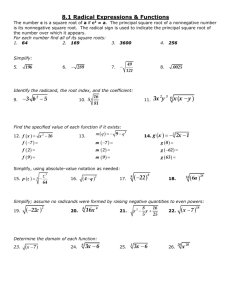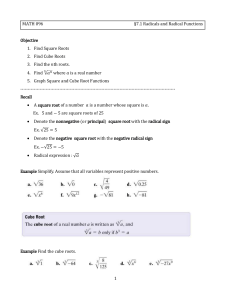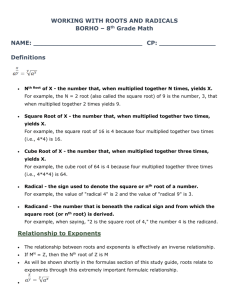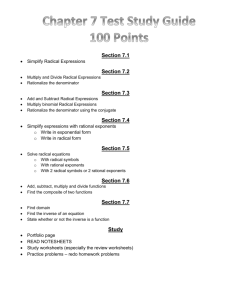Section 10.1
advertisement
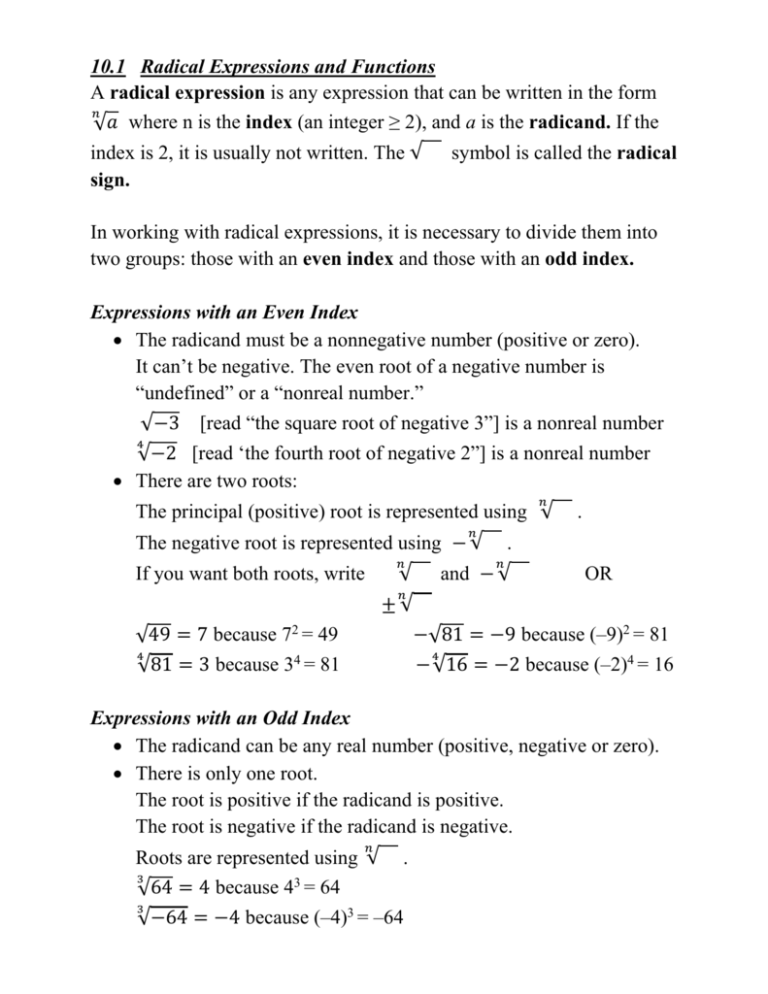
10.1 Radical Expressions and Functions
A radical expression is any expression that can be written in the form
𝑛
√𝑎 where n is the index (an integer ≥ 2), and a is the radicand. If the
index is 2, it is usually not written. The √
sign.
symbol is called the radical
In working with radical expressions, it is necessary to divide them into
two groups: those with an even index and those with an odd index.
Expressions with an Even Index
The radicand must be a nonnegative number (positive or zero).
It can’t be negative. The even root of a negative number is
“undefined” or a “nonreal number.”
√−3 [read “the square root of negative 3”] is a nonreal number
4
√−2 [read ‘the fourth root of negative 2”] is a nonreal number
There are two roots:
𝑛
The principal (positive) root is represented using √
𝑛
The negative root is represented using − √
If you want both roots, write
𝑛
√
.
.
𝑛
and − √
OR
𝑛
±√
√49 = 7 because 72 = 49
4
√81 = 3 because 34 = 81
−√81 = −9 because (–9)2 = 81
4
− √16 = −2 because (–2)4 = 16
Expressions with an Odd Index
The radicand can be any real number (positive, negative or zero).
There is only one root.
The root is positive if the radicand is positive.
The root is negative if the radicand is negative.
𝑛
Roots are represented using √ .
3
√64 = 4 because 43 = 64
3
√−64 = −4 because (–4)3 = –64
Radical Functions
A radical relation equates a radical expression in one variable to a
second (dependent) variable.
3
𝑦 = √𝑥
𝑦 = √2𝑥 + 5
If a radical relation is a radical function, it can be written using
function notation.
𝑓(𝑥) = √𝑥
3
𝑔(𝑥) = √2𝑥 + 5
A radical function is written in the form 𝑓(𝑥) = 𝐴(𝑥 ) where 𝐴(𝑥) is
a radical expression with the variable x in the radicand.
3
𝑓(𝑥 ) = √5𝑥 not a radical function because x is not part of the radicand
3
𝑓(𝑥 ) = 𝑥 √5 is a better way to write this
3
𝑔(𝑥 ) = 5 √𝑥 is a radical function
𝑝(𝑡) = √𝑡 + 3 is a radical function
Be careful when identifying the radicand. It is only that part of the
expression inside the radical sign.
𝑓(𝑥 ) = √2x the radicand is 2
Better is 𝑓(𝑥 ) = 𝑥√2
𝑔(𝑥 ) = √2𝑥 the radicand is 2x
ℎ(𝑥 ) = √2𝑥 + 5 the radicand is 2x+5
𝑗(𝑥 ) = √2𝑥 + 5 the radicand is 2x
Domain of a Radical Function
The domain of a function is the set of all real-number values for the
independent variable that give a real–number result. Any value that
doesn’t give such a result is excluded from the domain and is referred to
as a restricted value.
In radical expressions with an odd index, the radicand can be any real
number. So, radical functions defined by odd roots have no restricted
values. The domain for these functions is all real numbers.
{𝑥 |𝑥 is a real number} or (−∞, ∞)
In radical expressions with an even index, the radicand must be positive
or zero. These expressions are not defined for any negative number. So,
those real numbers that result in a negative radicand are restricted
values and must be excluded from the domain.
Finding the Domain Algebraically
Set up an inequality of the form
radicand ≥ 0
Solve the inequality.
Solutions to the inequality are the domain.
4
Example: Find the domain for 𝑓(𝑥) = √3𝑥 + 1.
3𝑥 ≥ 0
𝑥 ≥ 0
The radicand is 3x.
The domain is all real numbers greater than or equal to 0.
{𝑥| 𝑥 ≥ 0}
or
[0, ∞)
-------------------------------------------------------------------------------------Example: Find the domain for ℎ(𝑥) = √5𝑥 − 4 + 1.
The radicand is 5x – 4.
5𝑥 − 4 ≥ 0
5𝑥 ≥ 4
𝑥 ≥ 4/5
4
The domain is all real numbers greater than or equal to .
5
4
{𝑥| 𝑥 ≥ }
5
or
4
[ , ∞)
5
Example: Find the domain of the function 𝑔(𝑥) = √2𝑥 − 5 + 3
The radicand is 2x – 5.
2𝑥 – 5 ≥ 0
2𝑥 ≥ 5
𝑥≥
5
2
The domain is all real numbers greater than or equal to
5
{𝑥| 𝑥 ≥ }
or
2
5
2
5
[ , ∞)
2
-------------------------------------------------------------------------------------Evaluating Radical Functions
To evaluate radical functions, substitute the given value for the variable
and simplify. Do not leave the expression in radical form. Take the
indicated root rounding to two decimal places if necessary.
Example: For 𝑓 (𝑥 ) = √5𝑥 − 6 , find 𝑓(2).
𝑓(2) = √5 ∙ 2 − 6 = √10 − 6 = √4 = 2
𝑓(2) = 2
-------------------------------------------------------------------------------------Example: For 𝑔(𝑥 ) = −√64 − 8𝑥 , find 𝑔(−3).
𝑔(−3) = −√64 − 8 ∙ −3 = −√64 − (−24)
= −√64 + 24 = −√88 ≈ −9.38
𝑔(−3) ≈ −9.38
-------------------------------------------------------------------------------------3
Example: For 𝑓 (𝑥 ) = √𝑥 − 2 , find 𝑓 (127).
3
3
𝑓(127) = √127 − 2 = √125 = 5
𝑓 (127) = 5
-------------------------------------------------------------------------------------3
Example: For 𝑔(𝑥 ) = √8𝑥 − 8 , find 𝑔(−7).
3
3
3
𝑔(−7) = √8 ∙ −7 − 8 = √−56 − 8 = √−64 = −4
𝑔(−7) = −4
𝒏
Simplifying Radical Expressions of the Form √𝒂𝒏
Expressions with n even
𝑛
√𝑎𝑛 = |𝑎| This is the principal 𝑛𝑡ℎ root and must be positive.
𝑛
− √𝑎𝑛 = −|𝑎| This is the negative 𝑛𝑡ℎ root and must be negative.
√(−6)2 = |−6| = 6
√25𝑥 6 = |5𝑥 3 | or 5|x 3 |
√(𝑥 + 5)2 = |𝑥 + 5|
4
√(𝑥 − 2)4 = |𝑥 − 2|
8
−√(−5)2 = −|−5| = −5
− √𝑦 8 = −|𝑦|
Expressions with n odd
𝑛
√𝑎𝑛 = 𝑎 The sign of the root depends upon the sign of the radicand.
3
√53 = 5
3
√(−7)3 = −7
5
√(−3)5 = −3
3
√8𝑥 3 = 2𝑥
